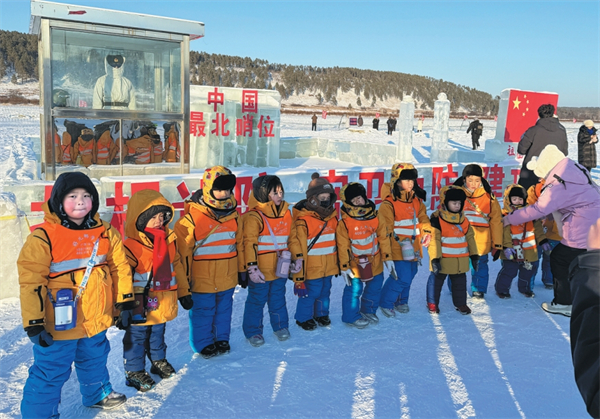Home>Harbin Today
Tiger cub births safeguard population growth
Updated : 2023-07-17
By ( e.my399.com )

Two Siberian tiger cubs sleep in a breeding box at the park in Harbin. ZHENG XUEFENG/FOR CHINA DAILY
Li Xin's life has been extremely busy this summer, after 24 cubs were born at the Siberian Tiger Park in Harbin, Heilongjiang province.
Since the 40-year-old became a breeding expert at the park in 2004, his life has been closely related to the big cats.
"I am responsible for feeding the tigers and monitoring their health, as well as cleaning out their living quarters," he said. "These large animals look fierce, but sometimes they are also naughty and lovely. After a long time together, we are just like interdependent friends."
The mating season for Siberian tigers usually falls in January and February. Every year during the birthing season, which runs from early April to late June, Li and three other breeding experts — Jia Teng, Song Zhiyang and Zhang Xu — take turns to work 24-hour shifts to monitor the pregnant tigers, which are moved to separate living quarters in a special area about one month before they give birth.
"Every day, the breeders carefully disinfected both the indoor and outdoor living areas," Li said. "The temperature in the living quarters stayed at 17 to 20 C, which was comfortable for the animals."
The experts paid great attention to the tiger moms, checking their health by monitoring their appetites and daily activities during the 105-to-110-day pregnancy period.
In addition, they prepared an ample supply of nutritious food — including milk and eggs, as well as several kinds of vitamin pills — to help maintain the animals' strength.
This year, eight tigers gave birth to cubs, including twins, triplets, quadruplets and quintuplets.
"Usually, Siberian tigers give birth to two to four cubs at a time, but it is rare to see healthy quintuplets" Li said, noting that on May 10, a tiger gave birth to five cubs in one batch.
Most of the young mothers have no experience of nursing cubs, so the four experts took on the task of feeding the young tigers.
"The cubs' body temperature dropped rapidly as their mothers did not take care of them after giving birth, so they had to be sent to the incubator and observed for 24 to 48 hours. After their body temperature returned to normal, they were taken to a designated room for artificial feeding," Li said.
"They needed to be fed with milk every three hours for the first week after birth," he added, noting that the milk was made from a commercial tiger formula powder. "We also had to pay great attention to their health by monitoring their appetites, body temperatures and feces." Li said that when the cubs are older, they will be fed chopped meat.
Siberian tigers are a critically endangered species, with fewer than 500 believed to be roaming free in the wild. They mainly live in northeastern China and eastern Russia.

Breeding expert Li Xin checks the temperature of a cub at the Siberian Tiger Park in Harbin, Heilongjiang province. ZHENG XUEFENG/FOR CHINA DAILY
The Harbin park is one of three run by the China Hengdaohezi Feline Breeding Center, the world's largest such facility for these rare tigers. The others are located in Mudanjiang, Heilongjiang, and Shenyang, Liaoning province.
During more than 30 years of research, the center has explored a complete set of scientific methods for the breeding and optimization of Siberian tigers.
Not all adult Siberian tigers are suitable for reproductive purposes, so researchers conduct DNA tests to select parents and prevent inbreeding," said Liu Dan, an expert on tigers at the Harbin park.
Every year, 30 high-quality, purebred Siberian tigers are selected for breeding at the park.
The center now has more than 800 tigers, a huge rise from the initial group of 20 when it was founded in 1986, thus providing a guarantee for the full recovery of the animal's population.

Harbin ramps up childcare services
A new comprehensive service center for childcare in Harbin is expected to be finished by the end of the year.
-
Talent policies drive enterprise development in Harbin
Harbin's "30 New Talent Policies" represents an iterative upgrade to the talent policy system, helping attract and retain talent to bolster economic and social development.
-
Official website of 2025 Asian Winter Games goes live
Harbin, the host city of the 9th Asian Winter Games, has announced that the official website for the 2025 event has recently gone live.
-
Harbin launches measures to facilitate more foreign trade
In the first three quarters of 2023, the total import and export value of Heilongjiang province's goods trade hit 218.22 billion yuan.





